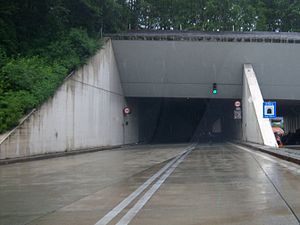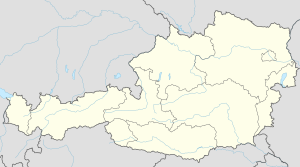Arlberg road tunnel
| Arlberg road tunnel | ||
|---|---|---|
|
Gallery at the east portal (view of the lane towards Vorarlberg)
|
||
| use | Road tunnel | |
| traffic connection | Vorarlberg - Tyrol | |
| place | Arlberg | |
| length | 13,972 m (15,537 m including galleries) | |
| vehicles per day | 8,807 (2014) | |
| Number of tubes | 1 | |
| cross-section | 90-103 m² | |
| Largest coverage | 850 m | |
| construction | ||
| Client | ASTAG (Arlberg Strasse Tunnel Aktiengesellschaft) | |
| building-costs | ATS 4 billion (1978; EUR 814 million adjusted for inflation) | |
| start of building | 5th July 1974 | |
| business | ||
| operator | ASFINAG | |
| toll | 10.50 euros (toll booth at the east portal) | |
| release | December 1, 1978 | |
| location | ||
|
|
||
| Coordinates | ||
| West portal | 47 ° 7 '47 " N , 10 ° 7' 12" E | |
| East portal | 47 ° 8 ′ 28 " N , 10 ° 18 ′ 48" E | |
The Arlberg road tunnel connects the Austrian states of Tyrol and Vorarlberg under the Arlberg . With a length of 13,972 m, it is the longest road tunnel in Austria , with a mountain overlap of a maximum of 850 meters. The Arlberg expressway S 16 runs through the tunnel , which is operated by ASFINAG .
history
With the increase in vehicle traffic in the 20th century, the Arlberg pass road had become inadequate. So the decision was made to build a road tunnel between Langen and St. Anton , which offers a winter-safe alternative to the pass road. In 1973, the Arlberg-Straßentunnel Aktiengesellschaft (ASTAG) was founded to finance the project, 60% of which belonged to the federal government, 26% to the state of Tyrol and 14% to the state of Vorarlberg. The company was later merged into ASFINAG . The construction cost 4.8 billion schillings (inflation-adjusted currently 977 million EUR), the pure construction costs amounted to 3.88 billion schillings.
Work began on June 1, 1974, and the construction of the tunnel in St. Anton and Langen took place on July 5, 1974. The breakthrough took place on October 9, 1977, and traffic was opened on December 1, 1978. The New Austrian Tunneling Method was used during construction . Although the mountain behavior did not meet expectations and, in particular, excessive rock movements had to be intercepted, the construction deadlines could be met. Originally, two tubes were planned at a distance of 70 m, the completed tunnel is the planned south tube.
In 2015 and 2017, ASFINAG carried out the first general renovation of the tunnel with extensive full closures and the installation of modern safety technology. From April 21 to November 15, 2015, the Arlberg road tunnel was completely closed for the first construction work for seven months. During this time, cars and trucks for the destination and source traffic were able to use the Arlberg Pass locally, while other trucks had to accept extensive detours. The second full closure of the tunnel lasted from April 24 to September 29, 2017. The renovation work was completed during this period.
course
The tunnel actually consists of two tunnels and galleries on both sides . At the east portal in St. Jakob there is an entrance gallery, followed by the St. Jakob ventilation center and the 3951 m long tunnel. The Rosanna is then crossed on an enclosed bridge before the actual Arlberg massif is crossed in the 10,311 m long main tunnel. At the west portal south of Langen there is again an entrance gallery and the Langen ventilation center. From the east portal ( 1223 m above sea level ) the tunnel climbs over 3940 m with 1.67% to the apex at the Rosanna crossing ( 1318 m above sea level ). Then it falls to 10,032 m in length with 1.3% to the west portal at 1188 m above sea level. A. from. With the entrance structures, the length is 15,537 m. The width of the tunnel is 9.40 m, of which 7.50 m is accounted for by the carriageway and 0.95 m for the sidewalks on both sides.
safety
The tunnel is designed for 1,800 vehicles per hour and equipped with four ventilation centers, twelve fans, a continuous switchable light strip, 43 TV cameras for traffic monitoring, emergency telephones at a distance of 212 m and 16 parking niches. Air is exchanged via two ventilation centers at the portals and two ventilation shafts. The Maienwasen ventilation shaft on the Tyrolean side has a diameter of 8.3 m and a depth of 218 m. The Albona ventilation shaft on the Vorarlberg side has a diameter of 7.7 m and a depth of 736 m.
To increase safety in the tunnel, eight connecting tunnels with a length of 150 m to 300 m to the parallel Arlberg railway tunnel were built in the first expansion stage . This means that the maximum escape route length is 1700 m. The connecting tunnels, which are separated from the driving area by locks , also have collecting rooms that can accommodate 800 people.
The original plan was to reduce the escape route distance to 850 m with eight further connecting tunnels to the railway tunnel in the second expansion stage from 2014. In the third and final expansion stage from 2016, a parallel escape tunnel was to be built with accesses every 425 m. This escape route planning was revised, however, from 2014 the supply air duct of the cross ventilation of the tunnel will be adapted to an escape tunnel, accesses to this air duct will be set up at a maximum distance of 500 m. Every 1700 m, those who flee in the event of an incident are then directed from the supply air duct / escape tunnel into the existing escape and rescue routes that connect the road tunnel with the railway tunnel.
- Safety devices
toll
Use of the tunnel is subject to a special toll . A single trip by car costs 10.50 euros (as of January 2019). Since this is a special toll route, the tunnel is not subject to the vignette requirement. The toll booth is in front of the east portal at St. Jakob on the Tyrolean side.
literature
- Klaus Fink : Arlberg road tunnel . In: The motorway network in Austria . 30 years of ASFINAG. Vienna 2012, p. 147-150 ( PDF, 7.6 MB ).
Individual evidence
- ↑ Permanent counting stations for the whole of 2014. (MS Excel) (No longer available online.) ASFINAG, archived from the original on March 5, 2016 ; accessed on January 9, 2016 . Info: The archive link was inserted automatically and has not yet been checked. Please check the original and archive link according to the instructions and then remove this notice.
- ↑ Tyrolean Greens and Vorarlberg Greens: 2nd tube at the Arlberg road tunnel: a crazy idea! ( Memento from July 14, 2014 in the Internet Archive )
- ↑ Arlberg tunnel: complete closure for seven months . Article by ORF Vorarlberg from April 14, 2015.
- ↑ Arlberg tunnel reopened ( memento of the original from October 2, 2017 in the Internet Archive ) Info: The archive link was automatically inserted and not yet checked. Please check the original and archive link according to the instructions and then remove this notice. accessed on October 2, 2017
- ↑ 136 million euros for more safety in the Arlberg tunnel. ASFINAG, February 22, 2013, accessed on July 11, 2014 .
- ↑ Line toll tariffs. ASFINAG, accessed on January 4, 2019 .
Web links
- Entry on Arlbergstrasse Tunnel in the Austria Forum (in the AEIOU Austria Lexicon )







